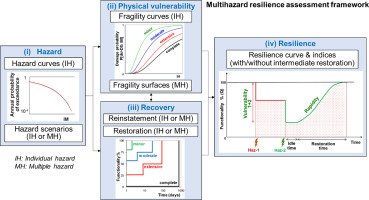当前位置:
X-MOL 学术
›
Sci. Total Environ.
›
论文详情
Our official English website, www.x-mol.net, welcomes your
feedback! (Note: you will need to create a separate account there.)
Resilience assessment framework for critical infrastructure in a multi-hazard environment: Case study on transport assets.
Science of the Total Environment ( IF 8.2 ) Pub Date : 2020-01-22 , DOI: 10.1016/j.scitotenv.2020.136854 Sotirios A Argyroudis 1 , Stergios A Mitoulis 2 , Lorenzo Hofer 3 , Mariano Angelo Zanini 3 , Enrico Tubaldi 4 , Dan M Frangopol 5
Science of the Total Environment ( IF 8.2 ) Pub Date : 2020-01-22 , DOI: 10.1016/j.scitotenv.2020.136854 Sotirios A Argyroudis 1 , Stergios A Mitoulis 2 , Lorenzo Hofer 3 , Mariano Angelo Zanini 3 , Enrico Tubaldi 4 , Dan M Frangopol 5
Affiliation

|
The exposure of critical infrastructure to natural and human-induced hazards has severe consequences on world economies and societies. Therefore, resilience assessment of infrastructure assets to extreme events and sequences of diverse hazards is of paramount importance for maintaining their functionality. Yet, the resilience assessment commonly assumes single hazards and ignores alternative approaches and decisions in the restoration strategy. It has now been established that infrastructure owners and operators consider different factors in their restoration strategies depending on the available resources and their priorities, the importance of the asset and the level of damage. Currently, no integrated framework that accounts for the nature and sequence of multiple hazards and their impacts, the different strategies of restoration, and hence the quantification of resilience in that respect exists and this is an acknowledged gap that needs urgently filling. This paper provides, for the first time in the literature, a classification of multiple hazard sequences considering their nature and impacts. Subsequently, a novel framework for the quantitative resilience assessment of critical infrastructure, subjected to multiple hazards is proposed, considering the vulnerability of the assets to hazard actions, and the rapidity of the damage recovery, including the temporal variability of the hazards. The study puts forward a well-informed asset resilience index, which accounts for the full, partial or no restoration of asset damage between the subsequent hazard occurrences. The proposed framework is then applied on a typical highway bridge, which is exposed to realistic multiple hazard scenarios, considering pragmatic restoration strategies. The case study concludes that there is a significant effect of the occurrence time of the second hazard on the resilience index and a considerable error when using simple superimposition of resilience indices from different hazards, even when they are independent in terms of occurrence. This potentially concerns all critical infrastructure assets and, hence, this paper provides useful insights for the resilience-based design and management of infrastructure throughout their lifetime, leading to cost savings and improved services. The paper concludes with a demonstration of the importance of the framework and how this can be utilised to estimate the resilience of networks to provide a quantification of the resilience at a regional and country scale.
中文翻译:

多灾种环境中关键基础设施的复原力评估框架:运输资产案例研究。
关键基础设施暴露于自然和人为因素的危害对世界经济和社会造成严重影响。因此,基础设施资产对极端事件和各种危害序列的复原力评估对于维护其功能至关重要。但是,复原力评估通常假设单一危害,而忽略了恢复策略中的替代方法和决策。现已确定,基础架构所有者和运营商会根据可用资源及其优先级,资产的重要性和破坏程度在其恢复策略中考虑不同的因素。目前,还没有一个综合框架能够说明多种危害及其影响,恢复的不同策略,因此,在这方面可以对抵御能力进行量化,这是一个公认的差距,需要紧急填补。考虑到它们的性质和影响,本文首次提供了多种危险序列的分类。随后,考虑到资产对危险行为的脆弱性以及损害追回的速度,包括危险的时间变化性,提出了一种新的框架,该框架对遭受多种危害的关键基础设施进行了定量的弹性评估。该研究提出了一个信息灵通的资产弹性指数,该指数说明了在随后的危险事件之间资产损害的全部,部分或没有恢复。然后将建议的框架应用于典型的公路桥梁,考虑到务实的恢复策略,该方法暴露于现实的多种危害情景中。案例研究得出的结论是,使用简单叠加来自不同危害的弹性指标时,第二种危害的发生时间会对弹性指标产生重大影响,并且会产生相当大的误差,即使它们在发生方面是独立的。这可能涉及所有关键基础架构资产,因此,本文为基于弹性的基础架构设计和管理在整个生命周期中提供了有用的见识,从而节省了成本并改善了服务。
更新日期:2020-01-22
中文翻译:

多灾种环境中关键基础设施的复原力评估框架:运输资产案例研究。
关键基础设施暴露于自然和人为因素的危害对世界经济和社会造成严重影响。因此,基础设施资产对极端事件和各种危害序列的复原力评估对于维护其功能至关重要。但是,复原力评估通常假设单一危害,而忽略了恢复策略中的替代方法和决策。现已确定,基础架构所有者和运营商会根据可用资源及其优先级,资产的重要性和破坏程度在其恢复策略中考虑不同的因素。目前,还没有一个综合框架能够说明多种危害及其影响,恢复的不同策略,因此,在这方面可以对抵御能力进行量化,这是一个公认的差距,需要紧急填补。考虑到它们的性质和影响,本文首次提供了多种危险序列的分类。随后,考虑到资产对危险行为的脆弱性以及损害追回的速度,包括危险的时间变化性,提出了一种新的框架,该框架对遭受多种危害的关键基础设施进行了定量的弹性评估。该研究提出了一个信息灵通的资产弹性指数,该指数说明了在随后的危险事件之间资产损害的全部,部分或没有恢复。然后将建议的框架应用于典型的公路桥梁,考虑到务实的恢复策略,该方法暴露于现实的多种危害情景中。案例研究得出的结论是,使用简单叠加来自不同危害的弹性指标时,第二种危害的发生时间会对弹性指标产生重大影响,并且会产生相当大的误差,即使它们在发生方面是独立的。这可能涉及所有关键基础架构资产,因此,本文为基于弹性的基础架构设计和管理在整个生命周期中提供了有用的见识,从而节省了成本并改善了服务。









































 京公网安备 11010802027423号
京公网安备 11010802027423号